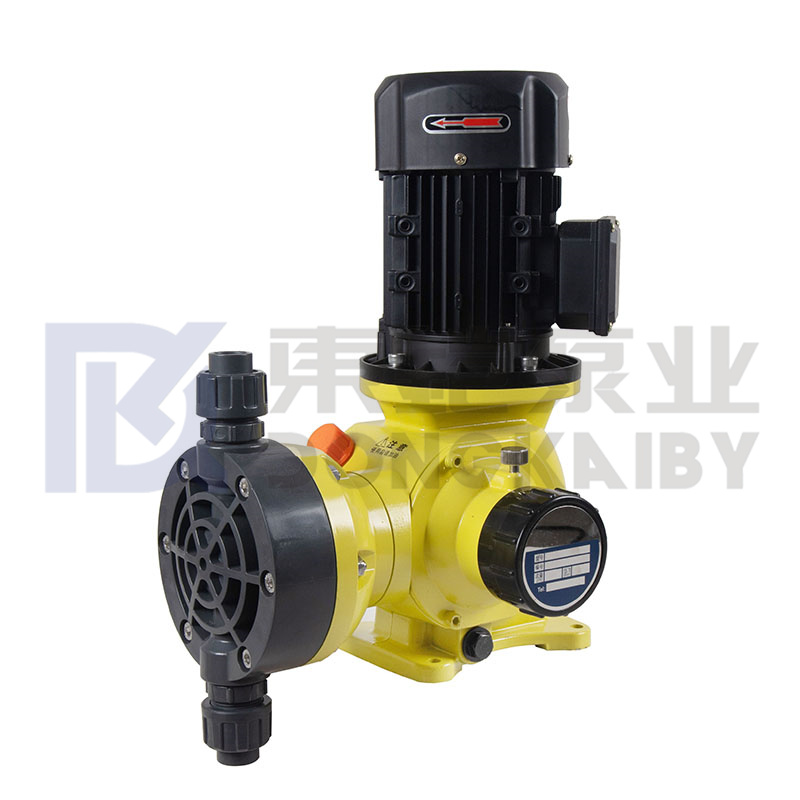- English
- Español
- Português
- русский
- Français
- 日本語
- Deutsch
- tiếng Việt
- Italiano
- Nederlands
- ภาษาไทย
- Polski
- 한국어
- Svenska
- magyar
- Malay
- বাংলা ভাষার
- Dansk
- Suomi
- हिन्दी
- Pilipino
- Türkçe
- Gaeilge
- العربية
- Indonesia
- Norsk
- تمل
- český
- ελληνικά
- український
- Javanese
- فارسی
- தமிழ்
- తెలుగు
- नेपाली
- Burmese
- български
- ລາວ
- Latine
- Қазақша
- Euskal
- Azərbaycan
- Slovenský jazyk
- Македонски
- Lietuvos
- Eesti Keel
- Română
- Slovenski
- मराठी
- Srpski језик
Knowledge of metering pump-What should I pay attention to when using metering pump for the first time
2022-02-17
Pay attention to the calibration and calibration of flow when using metering pumps for the first time. Metering pumps have passed the performance test of clean water at normal temperature before leaving the factory, and the test results and flow calibration curve are listed in the certificate.
After the first 12 hours of operation, the user should test and verify the pump to obtain the accuracy of the pump flow under specific operating conditions.
Preparation and inspection before starting
01 Check that the pump is firmly installed with the base, the pipeline is installed correctly, and the outlet pipeline is open. If there is no lubricating oil in the pump body, enough lubricating oil should be added into the pump body. The oil filling amount of JXM type pump is 500ml, and that of JZM type pump is about 1.2L. It is best to fill the pump body with the oil type of Mobilgear600 xp220.
02 Before the pump is powered on, the flow regulating handwheel is at zero scale. Before the flow regulating handwheel is increased from zero scale, check the suction and discharge pipelines to ensure that all stop valves are open.
03Start the metering pump and check the steering of the motor, which must be consistent with the arrow on the mounting flange of the motor (clockwise rotation as viewed from the fan blade side of the motor). If the steering is not correct, change the wiring.
04 It is strongly recommended to stop the pump when the temperature is lower than -10℃.
Start the pump and manually adjust the flow.
Once the inspection required above is completed, the metering pump can be started. Observe and listen to the metering pump.Loosen the stroke locking bolt on the pump adjusting seat to adjust the pump flow. Adjust the thousandth scale stroke adjusting knob to change the pump flow. For JXM pump, the flow is increased clockwise and decreased counterclockwise. JZM pump decreases the flow clockwise and increases the flow counterclockwise.
The whole stroke adjustment range is marked by percentage, and the minimum interval on the handwheel is 1%. After adjusting the knob to the required flow rate, tighten the stroke locking bolt by hand to keep the set flow rate.
Exhaust of the suction line and the discharge line is a very important step.For this reason, before the pressure test, run the pump without any discharge pressure, so that the conveying system is completely filled with liquid.A simple way to ensure perfusion is to install a three-way valve and stop valve at the outlet connection end of the pump.If the pump is not operated for a long time, the change of liquid temperature can generate gas in the system.In order to exhaust air, a valve should be installed on the outlet pipeline to exhaust gas through the process material when the pump is started.
Calibration of flow rate
After the first 12 hours of operation, the pump should be calibrated and tested, so as to find out the accurate flow rate under specific operating conditions. Usually, setting the pump flow rate at 100%, 50% and 10% flow rate is enough to show the performance of the pump in the whole regulating range.
The flow rate of the pump can be calculated by measuring the change of the liquid level of a calibration container. It is suggested that this method be used to calibrate dangerous liquids.Collecting and measuring the output liquid at the outlet of the pump can also calibrate the flow of the pump, but it is necessary to establish a liquid head at the discharge point of the liquid so that the pump can work accurately.
After the first 12 hours of operation, the user should test and verify the pump to obtain the accuracy of the pump flow under specific operating conditions.
Preparation and inspection before starting
01 Check that the pump is firmly installed with the base, the pipeline is installed correctly, and the outlet pipeline is open. If there is no lubricating oil in the pump body, enough lubricating oil should be added into the pump body. The oil filling amount of JXM type pump is 500ml, and that of JZM type pump is about 1.2L. It is best to fill the pump body with the oil type of Mobilgear600 xp220.
02 Before the pump is powered on, the flow regulating handwheel is at zero scale. Before the flow regulating handwheel is increased from zero scale, check the suction and discharge pipelines to ensure that all stop valves are open.
03Start the metering pump and check the steering of the motor, which must be consistent with the arrow on the mounting flange of the motor (clockwise rotation as viewed from the fan blade side of the motor). If the steering is not correct, change the wiring.
04 It is strongly recommended to stop the pump when the temperature is lower than -10℃.
Start the pump and manually adjust the flow.
Once the inspection required above is completed, the metering pump can be started. Observe and listen to the metering pump.Loosen the stroke locking bolt on the pump adjusting seat to adjust the pump flow. Adjust the thousandth scale stroke adjusting knob to change the pump flow. For JXM pump, the flow is increased clockwise and decreased counterclockwise. JZM pump decreases the flow clockwise and increases the flow counterclockwise.
The whole stroke adjustment range is marked by percentage, and the minimum interval on the handwheel is 1%. After adjusting the knob to the required flow rate, tighten the stroke locking bolt by hand to keep the set flow rate.
Exhaust of the suction line and the discharge line is a very important step.For this reason, before the pressure test, run the pump without any discharge pressure, so that the conveying system is completely filled with liquid.A simple way to ensure perfusion is to install a three-way valve and stop valve at the outlet connection end of the pump.If the pump is not operated for a long time, the change of liquid temperature can generate gas in the system.In order to exhaust air, a valve should be installed on the outlet pipeline to exhaust gas through the process material when the pump is started.
Calibration of flow rate
After the first 12 hours of operation, the pump should be calibrated and tested, so as to find out the accurate flow rate under specific operating conditions. Usually, setting the pump flow rate at 100%, 50% and 10% flow rate is enough to show the performance of the pump in the whole regulating range.
The flow rate of the pump can be calculated by measuring the change of the liquid level of a calibration container. It is suggested that this method be used to calibrate dangerous liquids.Collecting and measuring the output liquid at the outlet of the pump can also calibrate the flow of the pump, but it is necessary to establish a liquid head at the discharge point of the liquid so that the pump can work accurately.
Generally, it is not recommended to use this method to calibrate the flow, because it makes the operator directly face dangerous liquid, which may lead to accidents.In addition, it is very likely that the pump is in self-flow when measuring the flow by this method, so the measured data will be larger than normal and the flow adjustment has little influence on the actual flow. For safety reasons, one-way check valves are used at the filling point of the outlet pipeline near the high-pressure process vessel.



